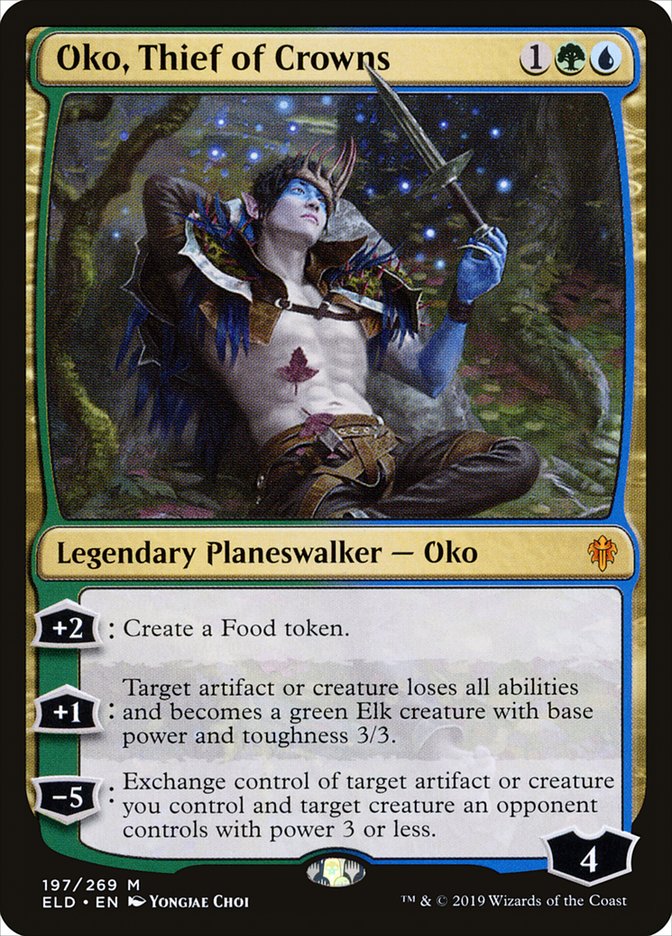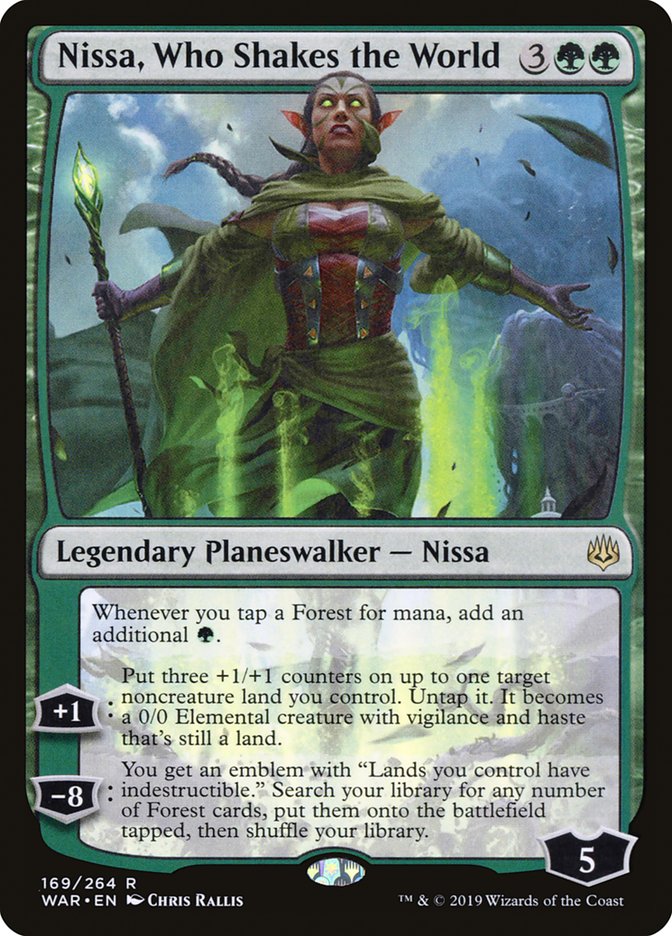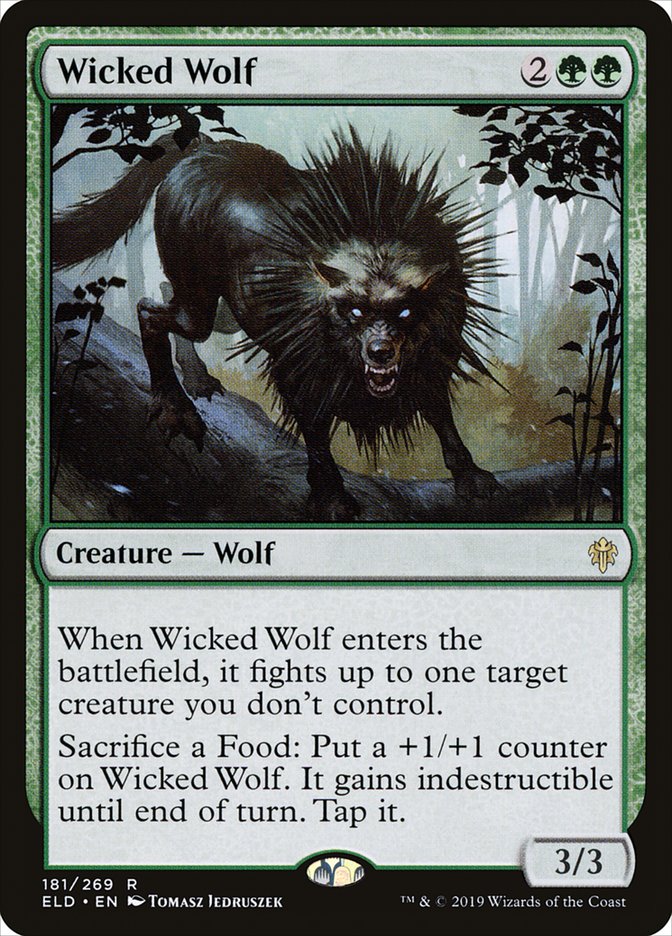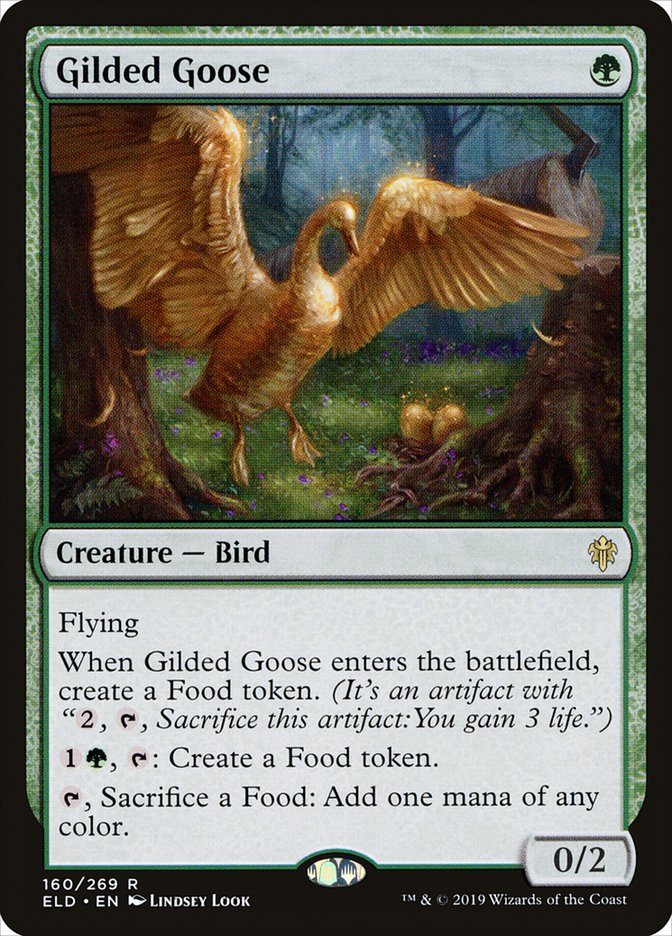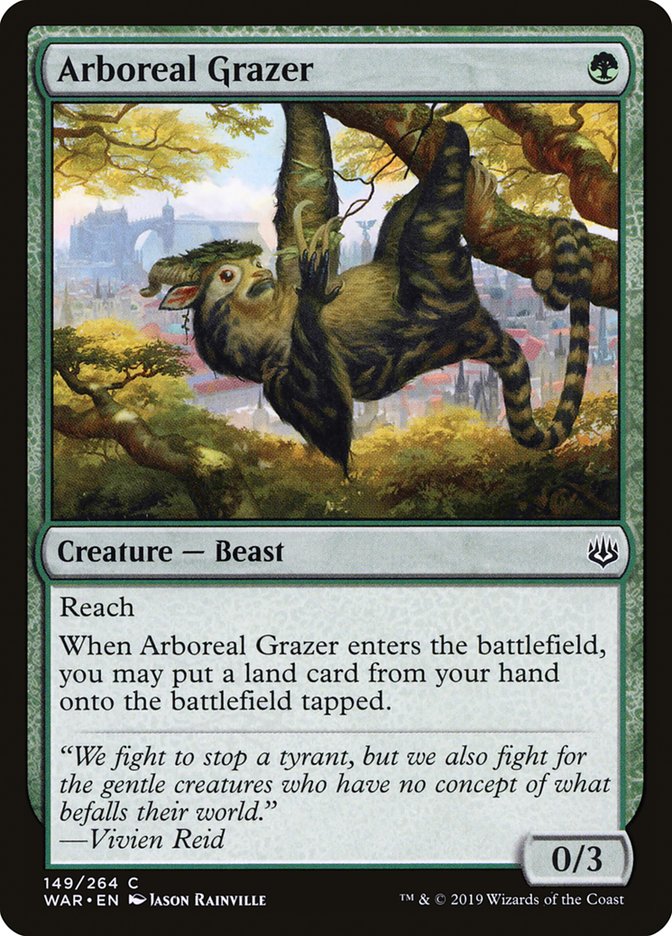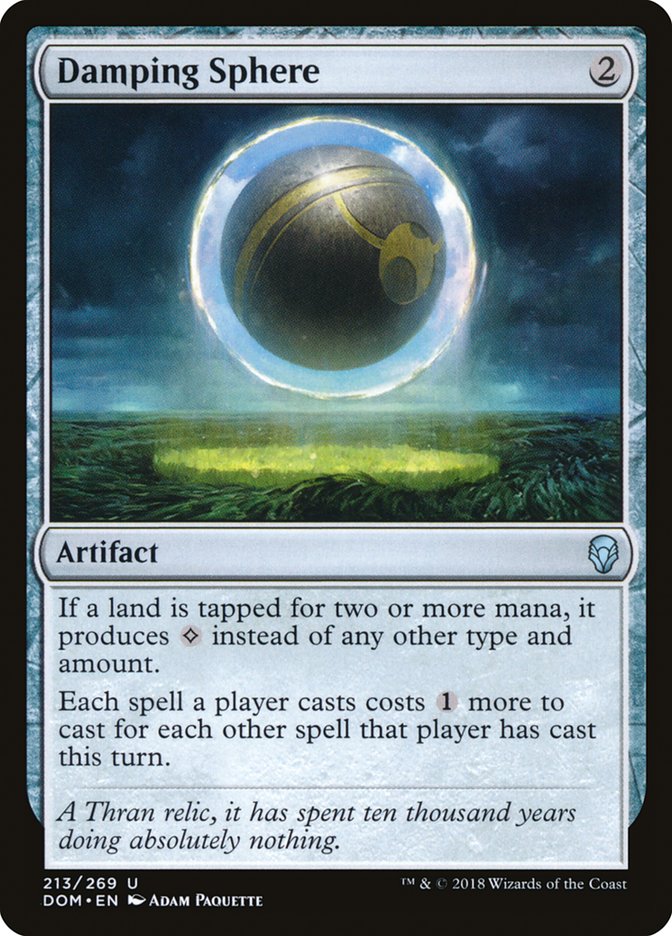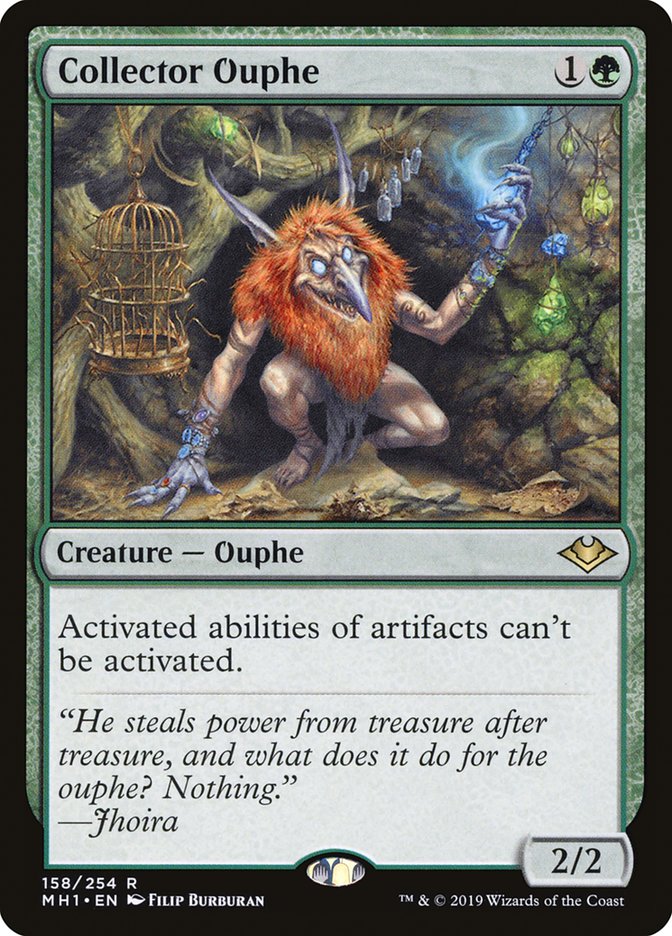My initial assessment of Oko, Thief of Crowns was that its fundamental play pattern was so strong that it would have to be great in Standard, and I even suspected that it might have a place in Modern. After watching it play out in Modern for the last of couple weeks, I believe it’s the strongest planeswalker ever printed. This doesn’t necessarily mean that it will be more dominant than Jace, the Mind Sculptor at its peak, since power level is contextual, but in Modern, for example, where both coexist, Oko is the stronger card.
I believe this is true across formats with a few possible exceptions. For example, Wrenn and Six is likely the strongest planeswalker in Legacy because of the interaction with Wasteland and the constraints that interaction along with cards like Daze put on the format in terms of casting spells that cost more than two mana.
In Vintage, where Wasteland is legal but the Moxes make it less defining than it is in Legacy, Wrenn and Six isn’t the strongest planeswalker, and I think that honor either goes to Karn, the Great Creator; Narset, Parter of Veils; or Oko, Thief of Crowns, and I’m not sure which it is. Karn shuts off opposing Moxes in addition to doing normal Karn things, Narset has an abundance of card draw to hate and super-powerful restricted cards to find, and Oko generally plays too fair a game. Using Oko in combination with Oath of Druids and turning your opponent’s artifact into a creature to trigger Oath of Druids might put it in the conversation, but it’s still most likely weaker than the other two.
In Commander, I think Oko might win in a landslide, since the high loyalty decreases the vulnerability to being attacked by multiple opponents, and the trade ability is more likely to find a high-value target. Also, people play tons of super-high-impact creatures and artifacts, and the Elk that Oko can turn them into is almost completely meaningless in the format.
With those quick hits aside, let’s get to an analysis of Oko in Modern and Standard.
Oko has stiff competition in Standard between Teferi, Time Raveler and Nissa, Who Shakes the World. Still, Oko will be the most-played of those cards at Mythic Championship V despite the fact that it’s relatively weak against Field of the Dead.
If Field of the Dead is banned and Oko remains legal, I have real concerns about Oko taking over the format, and what’s worse is what Oko will do to how we read previews in upcoming sets. Any exciting creature or artifact that costs four or more mana (that doesn’t have haste or an effect on entering the battlefield) will be met with the point that it fails the Oko Test, which is to say that it just isn’t worth casting because it will always become a 3/3 Elk.
Before I get too far ahead of myself, I should go over the basic discussion of Oko’s play pattern that answers the question, “Why is Oko so good?” The answer largely comes down to Oko’s incredibly high loyalty, but there’s a little more to it.
When it’s cast on an empty battlefield, the only thing to do with Oko is to use the +2 ability and create a Food token. This means that you have a Food token and a six-loyalty planeswalker and your opponent has nothing, but it’s their turn. If they cast a creatures that’s 3/3 or smaller, you have a choice – you can either use Oko’s second ability to go up to seven loyalty and turn your Food token into a creature that beats or trades with theirs in combat, or you can use Oko’s third ability to give your opponent your Food and take their creature, leaving your Oko at one loyalty, and then you also get to cast another spell. Assuming that’s just some creature, you now either have two creatures to their one and a seven-loyalty planeswalker or two creatures to their zero and a one-loyalty planeswalker.
If your opponent casts a bigger creature, you can’t steal it, so your options are a little worse and you might need to rely on your following spell to answer it, but if your following spell is a Wicked Wolf, for example, no matter what they cast, you could turn it into a 3/3 and then use the Food you created the previous turn with Oko to kill their creature with your Wolf after making it a 4/4.
All of this is to say that Oko is extremely hard to answer in combat, so it largely requires a spell to deal with it (or, as we see in Throne of Eldraine Standard, you can go way over the top of its threat generation by, for example, making lots of 2/2s with Field of the Dead). The issue with using a spell to deal with it is that, again, it has six loyalty after its first activation, so it’s out of range of any red spell. So your options for trading with it at a favorable rate are extremely limited, and even if you do, it still leaves a Food token behind, so your next Oko can function as a 3/3 haste creature.
Now, I’ll grant that maybe saying that a planeswalker is good on an empty battlefield isn’t that meaningful of a statement, as most planeswalkers are good on empty battlefields, but Oko only costs three mana and Oko is green, which means it’s far more likely than most planeswalkers to be cast on an empty battlefield. In Standard, it can be cast on Turn 2 after casting either Gilded Goose or Arboreal Grazer, and it plays particularly well with either one, in that Oko and Gilded Goose each make Food for the other one, so you can keep making mana or keep making Elks as needed, and with Arboreal Grazer, you can immediately turn the Grazer into an Elk and attack for three on Turn 2.
The “attack for three on Turn 2 mode” really makes Oko shine in Modern. It plays exceptionally well in artifact decks where Mox Opal can make it easy to cast Oko early, and then you can turn an Arcum’s Astrolabe or any zero-mana artifact into a 3/3 and start attacking. In these decks that have a lot of very-low-investment artifact generation, Oko can function as a supercharged, cheaper Gideon, Ally of Zendikar that gains loyalty to make 3/3s every turn, except the 3/3s can attack right away (because you’re using the ability on artifacts that were already on the battlefield) and the Oko gains loyalty and costs less mana.
Still, this is mostly operating on a conceptual/theoretical level. Some people might only be convinced by results. As I mentioned, Oko’s going to be the most-played planeswalker in Throne of Eldraine Standard at Mythic Championship V this weekend and it has less competition there, so I’m going to focus on Modern to make my case.
I talked about how Oko theoretically plays in the artifact decks, and Oko’s been widely adopted as a sideboard card in most Urza strategies. At the Modern Open at SCG Indianapolis, Oliver Tomajko, for example, finished highest among Urza decks with Urza Ascendancy, as a Jeskai deck that splashed green for four sideboard cards, three of which were Oko. Oliver only had a single Teferi in the sideboard, so he could have played four instead of adding a color if he just wanted three-mana planeswalkers, but Oko is enough better to justify adding another color and playing a maindeck Breeding Pool in his Jeskai deck.
Creatures (9)
Planeswalkers (2)
Lands (18)
Spells (31)

Oko’s particularly good in the Urza mirrors, where an Oko on the battlefield can lock the opponent out of playing an Urza unless they can win immediately because the threat of stealing Urza would be too costly.
Behind him, Zan Syed had the full four in his sideboard in a very similar deck. Harlan Firer and Autumn Burchett each had two in their sideboard in Four-Color Whirza and Urza Outcome respectively.
Creatures (10)
Planeswalkers (2)
Lands (18)
Spells (30)

Creatures (7)
Lands (20)
Spells (33)

Creatures (9)
Planeswalkers (2)
Lands (18)
Spells (31)

Oko’s widely included in Urza strategies, but always as a sideboard card. Why is that?
While Oko has synergy with the deck, both in terms of having a lot of low-impact cards to upgrade to 3/3s and creating artifacts that become “Mox Sapphire” when Urza’s on the battlefield, Urza strategies are extremely high-synergy and generally not looking to attack with 3/3s as a meaningful part of their gameplan. They’re midrange, interactive combo decks and Oko plays too fair a game for their maindeck. After sideboarding, they expect the opponent will become better at disrupting their combo plans and they’ll have to rely more on combat, or maybe they’ll need to answer hate cards, and Oko is great at both things.
We’ll see this come up more and more often in Modern. The reason Oko is so great as a sideboard card in Modern is that it answers opposing sideboard cards, in this case, cards like Chalice of the Void, Damping Sphere, and Collector Ouphe, while also offering a compact Plan B that can potentially win a game on its own.
So where does this come up outside of Urza?
Hall of Famer Gabriel Nassif has been streaming lately with a few takes on CrabVine, which he’s had a lot of early success with following Andreas Ganz’s MCQ win with the archetype.
Updated version of Once Upon a Vine (I like that name). Got to a cross between @Bashir_____ (Gul Dukat) and @Pfluegmeischter (Andreas Ganz who won his PTQ) list after playing a bunch. Think Glimpse>Grisly Salvage and want Once Upon a Time in the deck (and prob want the 4th). pic.twitter.com/GW5xhcEXCp
— gabriel nassif (@gabnassif) October 15, 2019
This deck can sideboard Oko in against anyone as a hedge that can answer Grafdigger’s Cage, Yixlid Jailer, or Scavenging Ooze. Even if the opponent has Leyline of the Void or Rest in Peace that you don’t have another answer for, Oko can turn your one- and zero-power creatures into 3/3s, giving your backdoor plan of attacking with horrible creatures some real teeth, especially against an opponent who maybe took too many mulligans to find a hate card. Expect Oko to become increasingly common as a way to make this kind of pivot.
Zach Allen had two Okos in the sideboard of Amulet Titan. Oko contributes well to Amulet Titan’s sideboard midrange strategy. It’s easily cast if your opponent is attempting to disrupt your mana or counter your spells with Disdainful Stroke and also answers Damping Sphere.
Creatures (13)
Lands (29)
- 2 Forest
- 2 Snow-Covered Forest
- 2 Gemstone Mine
- 1 Boros Garrison
- 1 Selesnya Sanctuary
- 1 Sunhome, Fortress of the Legion
- 2 Gruul Turf
- 2 Breeding Pool
- 1 Ghost Quarter
- 4 Simic Growth Chamber
- 1 Vesuva
- 3 Tolaria West
- 1 Bojuka Bog
- 1 Slayers' Stronghold
- 1 Cavern of Souls
- 1 Radiant Fountain
- 1 Field of the Dead
- 2 Castle Garenbrig
Spells (18)

Apart from Oko’s role in transforming and fighting hate cards, it’s worth noting that Oko itself is a hate card, in that some strategies are fundamentally weak against the card. Burn has a horrible time racing the life the Food tokens offer or competing with Oko’s high loyalty, it’s great at coming down early and pressuring opposing planeswalkers against Azorius Control, and it lines up well against decks like Death’s Shadow that have a small number of high-impact threats that it can turn into low-impact threats.
All these reasons touch on why I even played Oko in my sideboard in Mystic Sultai despite my reluctance to play sorcery-speed cards.
Creatures (5)
Lands (24)
Spells (31)

Oko performed exceptionally well for me. Before the tournament, I wasn’t sure exactly where I’d want it or how good it would be, and during the tournament, I realized that Amulet Titan was a horrible matchup for me, which wasn’t a great thing to realize in a tournament where it was tied for the most-played deck, but I discovered that Oko was also a reasonable desperation move that I could add to my deck in any bad matchup where I needed to be able to close a game quickly, something my deck generally can’t do, and it actually let me win a match against Amulet Titan.
Everyone I’ve talked to who’s played the card has reported great results, so I actually think it’s underplayed as a maindeck card at this point, and my next focus in Modern is finding decks that can take advantage of it. This is my next project:
Creatures (15)
Planeswalkers (7)
Lands (21)
Spells (17)

This is an effort to combine the best late-game aspects of Mystic Sultai’s ability to take advantage of Mystic Sanctuary, particularly with Cryptic Command, with a more proactive gameplan that can take advantage of the strength of the three-mana planeswalkers available.
I’m excited about how Ice-Fang Coatl and Spell Queller allow you to keep your creature count up to be proactive and to defend planeswalkers while respectively doubling as removal and counterspells. I’m also very excited about the idea of having mana creatures to cast Cryptic Command earlier. I think the question of Gilded Goose or Birds of Paradise is pretty close. I can see this deck wanting to use all its mana, where Birds of Paradise is better, but I also think the advantage of getting a Food left over if the opponent kills Gilded Goose is pretty big, and I like that it does something proactive as the game goes long in making Food. There’s a good chance a split is right, but it’s better for me to start with Gilded Goose, since I know exactly how Birds of Paradise plays.
Another fairly similar idea is to take the same planeswalker and Spell Queller core and combine it with Urza instead of Mystic Sanctuary:
Creatures (15)
Planeswalkers (5)
Lands (19)
Spells (21)

Here it’s very important that the Gilded Goose is Gilded Goose instead of Birds of Paradise or Noble Hierarch because the Food is being used to turn on Mox Opal and decrease the cost of Emry, Lurker of the Loch. In some ways, the actual Goose is the bonus value we’re getting off the one mana we’re paying for a Food.
The weakness that Mystic Sultai is built to exploit in Urza Outcome is that the deck plays a lot of “air” / low-impact cards and a few super-high-impact payoffs. This deck is built to remove that vulnerability. While there’s a lot of synergy here, the cards are mostly strong independently, and the deck is designed to play a fair, interactive game that just happens to be able to gain infinite life with Urza and the Thopter Foundry / Sword of the Meek Combo, but mostly Urza, Oko, and Emry are all amazing standalone cards that require fairly different answers. For a deck that’s just 60 permanents, it’s remarkably interactive.
I’m not sure what the best maindeck to take advantage of Oko is, but we’re only weeks into Modern and we’re seeing what I consider unprecedented proliferation of Oko across a variety of archetypes as people are just starting to figure out the card. It’s a radical statement now, but I think in a few months it could be generally understood that Oko is the strongest planeswalker we’ve seen so far.


